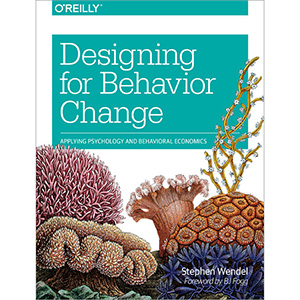Designing for Behavior Change

A new wave of products is helping people change their behavior and daily routines, whether it’s exercising more (Jawbone Up), taking control of their finances (HelloWallet), or organizing their email (Mailbox). This practical guide shows you how to design these types of products for users seeking to take action and achieve specific goals.
Stephen Wendel, HelloWallet’s head researcher, takes you step-by-step through the process of applying behavioral economics and psychology to the practical problems of product design and development. Using a combination of lean and agile development methods, you’ll learn a simple iterative approach for identifying target users and behaviors, building the product, and gauging its effectiveness. Discover how to create easy-to-use products to help people make positive changes.
- Learn the three main strategies to help people change behavior
- Identify your target audience and the behaviors they seek to change
- Extract user stories and identify obstacles to behavior change
- Develop effective interface designs that are enjoyable to use
- Measure your product’s impact and learn ways to improve it
- Use practical examples from products like Nest, Fitbit, and Opower
Table of Contents
Part I: Understanding the Mind and Behavior Change
Chapter 1. How the Mind Decides What to Do Next
Chapter 2. Why We Take Certain Actions and Not Others
Chapter 3. Strategies for Behavior Change
Part II: Discovering the Right Outcome, Action, and Actor
Chapter 4. Figuring Out What You Want to Accomplish
Chapter 5. Selecting the Right Target Action
Part III: Developing the Conceptual Design
Chapter 6. Structuring the Action
Chapter 7. Constructing the Environment
Chapter 8. Preparing the User
Part IV: Designing the Interface and Implementing It
Chapter 9. Moving from Conceptual Designs to Interface Designs
Chapter 10. Reviewing and Fleshing Out the Interface Designs
Chapter 11. Turning the Designs into Code
Part V: Refining the Product
Chapter 12. Measuring Impact
Chapter 13. Identifying Obstacles to Behavior Change
Chapter 14. Learning and Refining the Product
Part VI: Putting It into Practice
Chapter 15. Common Questions and a Start-to-Finish Example
Chapter 16. Conclusion
Appendix A. Glossary of Terms
Appendix B. Resources to Learn More
Appendix C. Bibliography
Appendix D. About the Author
Book Details
- Paperback: 400 pages
- Publisher: O’Reilly Media (November 2013)
- Language: English
- ISBN-10: 1449367623
- ISBN-13: 978-1449367626














